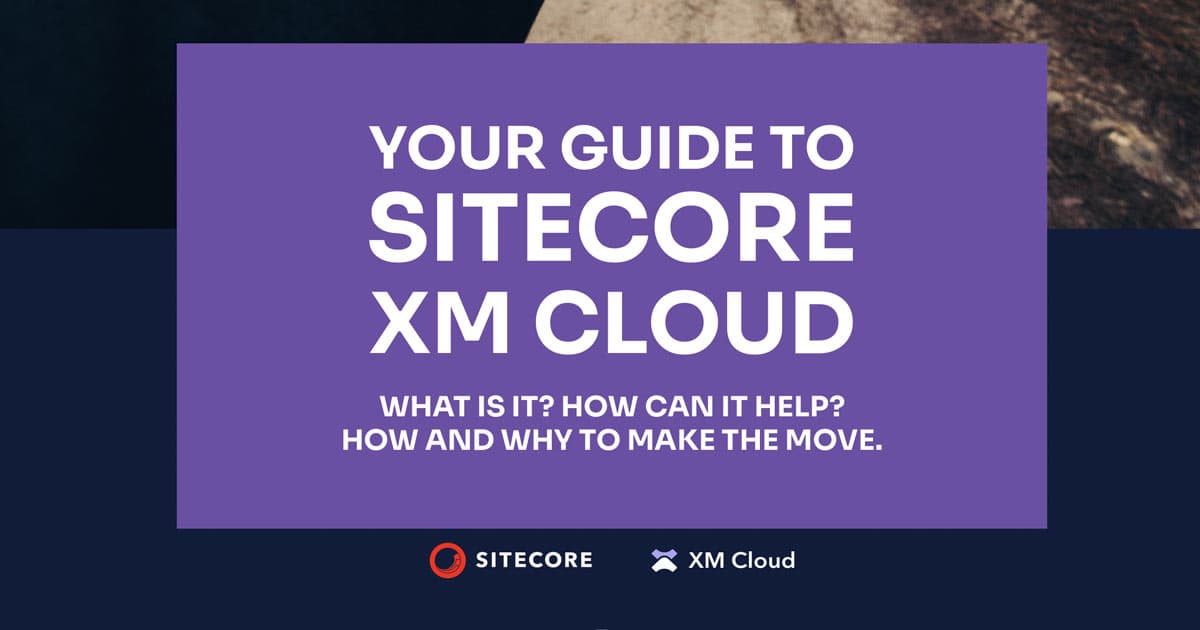
Practical Considerations For Moving to Sitecore XM Cloud




Feb 08, 2023
UPDATED: Oct 24, 2024
For Sitecore XP customers, moving to XM Cloud has probably crossed their minds more than once. But when do you know the time is right to make the move, and what should you consider before doing so?
In this post, we’ll explain why now is a good time to migrate to XM Cloud and provide some things you need to consider, especially if you are moving from another Sitecore system like Sitecore XM/XP.
Why XM Cloud?
Sitecore XM Cloud is a modern SaaS CMS built on headless, cloud-native architecture. It enables enterprises to create, manage, and deliver personalized experiences to any channel.
This means businesses can find similar functionality to other Sitecore solutions, such as Sitecore XP/XM, which include robust content management capabilities and features such as drag and drop functionality, WYSIWYG editing, and multilingual sites.
XM Cloud also offers additional benefits since it is a cloud-native solution. This includes a lower total cost of ownership, no more manual upgrades, reduced maintenance costs, improved scalability, and robust security and reliability.
However, before realizing these benefits, enterprises must carefully consider several factors to avoid surprises.
Factors to Consider Before Migrating to XM Cloud
Like any other composable solution, businesses need to be aware of certain factors. These factors are even more critical for Sitecore XP users considering XM Cloud.
Defining Business Objections
Before implementing a new and expensive marketing technology, businesses should clearly understand their reasons for doing so. For customers migrating from XM Cloud, these reasons will likely be to attain the benefits of moving to the cloud, such as reduced maintenance and a lower total cost of ownership. They could also be looking to migrate to get the performance benefits of a headless website, including improved Google Lighthouse scores and SEO rankings.
Industry-Specific Compliance Requirements
Businesses in highly regulated industries such as financial services or healthcare may be required to host their infrastructure on-premises or in a privately managed cloud. As such, they might not be in the best position to adopt Sitecore XM Cloud instead of Sitecore XP.
The Costs of Going Headless
Moving from a traditional website to a headless one often comes with increased costs that many customers must be aware of. The first cost is the need to rebuild the entire website in a headless manner, which is why many customers opt to perform an XM Cloud migration as part of a planned redesign.
Additionally, businesses must launch a headless website using a rendering host such as Vercel or Netlify. These platforms offer caching and content delivery network (CDN) capabilities, which are critical for ensuring the website loads quickly for users regardless of location.
The Need for Search
Sitecore XP customers may have been accustomed to having built-in search capabilities as part of their digital experience platform (DXP). However, Search doesn’t come built-in with XM Cloud. Instead, customers must also purchase and integrate Sitecore Search to have site search functionality and predictive text recommendations.
Developer Team Capabilities
Although both XP and XM Cloud are Sitecore products, they have different development paradigms, requiring another set of skills from internal developers or external agencies currently working with XP. While Sitecore XP requires .NET, XM Cloud leverages advanced JavaScript. Consequently, developers must be ready to use JavaScript technologies or be prepared to conduct the necessary training to manage the new implementation.
Adjusting to the New Feature Paradigm
With the introduction of XM Cloud, the philosophy around finding the right functionality for a digital experience stack has changed. Previously, XP customers might have been used to having all features found in one system. However, not all features may have worked well or suited their needs.
Although XM Cloud offers many of XP’s core features, its approach differs from that of Sitecore XP. With XM Cloud's composable philosophy, companies can add the best features and tools to fit their use cases by adding additional composable products.
For instance, XM Cloud offers built-in personalization capabilities, such as the rule-editor-type approach, similar to how personalization is managed in XP. However, to achieve a complete personalization experience, they will need to implement Sitecore Personalize and possibly Sitecore CDP alongside XM Cloud.
Should You Stick With Sitecore XM/XP?
After considering everything that XM Cloud offers, you might be tempted to stay on Sitecore XM/XP and simply upgrade to the latest version as necessary. Here’s where that might make sense:
-
You are in a highly regulated industry and need total control over your customer data.
-
Your business is using all of the features that Sitecore XP offers.
-
The total cost of ownership of using Sitecore XP hasn’t become a burden.
-
Sitecore XP is deeply integrated with the rest of your tech stack, and making the move would be too complex.
However, for companies using Sitecore XM rather than Sitecore XP, planning to migrate to XM Cloud is likely the best choice. You will align better with Sitecore’s proposed vision and roadmap, and XM Cloud will likely receive more extensive feature updates over the coming years than Sitecore XP.
How to Approach a Headless Migration with XM Cloud
Businesses eager to achieve the cloud and performance benefits of XM Cloud should consider this approach before making the move.
1. Conduct a technical audit.
The first step before migration is to conduct a technical audit of the current technology infrastructure and systems in play. This will tell you how ready your organization is to move its marketing infrastructure to SaaS and the other business critical systems that might need to be included in a composable solution, such as Search, Personalization, or Content Hub as a content marketing platform (CMP).
Knowing these details beforehand can make the entire implementation process much faster than implementing each tool one after the other.
2. Build a headless website on Sitecore XM/XP.
Customers with a traditional Sitecore XP/XM website should build headless websites on the platform before migrating to XM Cloud. This allows them to achieve two goals. The first is to test whether or not they will gain the performance benefits they are looking for by going headless before undertaking a total migration and website redesign project.
Instead, run a Google Lighthouse test on the current home page. Then, start rebuilding your home page headlessly on Sitecore XM/XP. Rerun a Lighthouse test to see if the benefits are what you were hoping for. If they are, you can focus on redesigning and rebuilding the entire website using a headless approach.
Additionally, a big-bang migration to XM Cloud is likely not feasible for enterprises with hundreds of websites and thousands of pages. Rebuilding websites using a headless approach allows them to make the transition to XM Cloud easier and faster as customers avoid paying license costs for both platforms simultaneously or paying to break the XP/XM license prematurely.
For an enterprise with hundreds of websites, a migration to XM Cloud could take as much as two years to complete. The websites can be rebuilt during this time to make the transition easier and incorporate other composable products such as Personalize and CDP. The migration can be completed once the XP/XM license is up.
3. Retrain editors and developers
Although the differences between XM Cloud and XP are less pronounced than if migrating from Sitecore XP to another CMS vendor, there are still important considerations. Developers must be experienced with JavaScript rather than the .NET framework. If existing developers are not up to speed on JavaScript, they will need to be retrained, or new developers will need to be hired. This can be done while rebuilding traditional websites using a headless approach. Training on the XM Cloud Pages editor for content editors can begin once the migration is complete.
Building a Migration Roadmap with Oshyn
Migrating to any new CMS doesn’t always go smoothly. In these situations, it helps to have a supporting partner to help with the process so that you avoid costly delays that impact marketing programs and revenue.
Oshyn is a certified Sitecore partner and offers extensive content management expertise. We are well-versed in various Sitecore services and have helped numerous enterprises complete migrations, implement Sitecore products, and create memorable experiences for their customers. With our guidance, you can discover the best approach to moving to XM Cloud for your business. If you decide you want to stick with Sitecore XP, we can help you upgrade to the latest version to keep your business running smoothly.
The California Teachers Association Member Benefits (CTAMB) organization sought to enhance its website's performance. When deciding between upgrading to the latest version of Sitecore XP or transitioning to XM Cloud, they chose to migrate to XM Cloud. This move allowed them to take advantage of automatic upgrades and a lower total cost of ownership over five years. With the help of Oshyn, they implemented a composable solution that integrated XM Cloud and Sitecore Search, resulting in a 40% improvement in Google Lighthouse Scores and PageSpeed Insights.
Learn more about the benefits of XM Cloud in our Guide to Sitecore XM Cloud.






